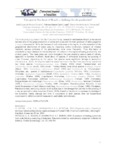Please use this identifier to cite or link to this item:
http://www.alice.cnptia.embrapa.br/alice/handle/doc/1060140| Title: | Vine pest in Northeast of Brazil: a challenge for the production? |
| Authors: | OLIVEIRA, J. E. de M.  LOPES, F. S. C.   FERNANDES, M. H. de A.   |
| Affiliation: | JOSE EUDES DE MORAIS OLIVEIRA, CPATSA; FABIANA SOARES CARIRI LOPES, Universidade Federal Rural de Pernambuco; MARIA HERLÂNDIA DE A. FERNANDES, UNIVASF. |
| Date Issued: | 2016 |
| Citation: | In: INTERNATIONAL SYMPOSIUM ON TROPICAL WINES, 5., 2016, Petrolina. Book of abstracts... Petrolina: Embrapa Semiárido, 2016. |
| Pages: | p. 21. |
| Description: | The vines producing areas in the São Francisco Valley, located in northeastern Brazil, is the second national pole of the grape production of wines and juices and the main producer of table grapes for in natura consumption. With the increase of cultivated areas in the region, it is the expansion of the geographical distribution of insect pests by dispersing and/or involuntary transport of infested materials, serious problems of the phytosanitary order occur frequently. Thus, this factor is considered a major obstacle to the development of culture in this region affecting productivity and product quality. The insect pests can occur throughout the year attacking various parts of culture, especially in bunches. In Brazil, listed about 40 species of arthropods attacking the growing of vines. However, depending on the region, few species cause significant damage to production (Oliveira et al., 2010). Among the pests that attack the vine in the São Francisco Valley, stands the two mites species Polyphagotarsonemus latus (Banks, 1904) (Acari: Tarsonemidae) and Tetranychus urticae (Koch, 1836) (Acari : Tetranychidae); three thrips species Retithrips syriacus (Mayet, 1890), Selenothrips rubrocinctus (Giard, 1901) and Frankliniella sp. (Thysanoptera: Thripidae); any species of lepidopterous Cryptoblabes gnidiella (Millière, 1864) (Lepidoptera: Pyralidae), Spodoptera frugiperda (Smith, 1797), Spodoptera eridania (Stoll, 1782), Spodoptera cosmioides (Walker, 1858), (Lepidoptera: Noctuidae), Helicoverpa armigera (Hübner, 1805) (Lepidoptera: Noctuidae); cochineal Eurhizococcus brasiliensis (Hempel, 1922) (Hemiptera: Margarodidae) and mealybugs Planococcus citri (Risso, 1813), Dysmicoccus brevipes (Cockerell, 1893) e Phenacoccus solenopsis Tinsley, 1898 (Hemiptera: Pseudococcidae). Recently, it was found the presence of pink hibiscus mealybug, Maconelicoccus hirsutus (Green, 1908) (Hemiptera: Pseudococcidae), becoming a factor to be studied due to the damage that can lead to the growing of vines, as reported in other countries (Vitullo, 2009). Based on the above, is necessary knowledge of the dynamics, habits, damage and time of occurrence of each species, they are fundamental importance for effective control measures to used safely and rationally. |
| Thesagro: | Uva Doença Praga Inseto Polyphagotarsonemus Latus Tetranychus Urticae |
| NAL Thesaurus: | Grapes |
| Keywords: | Vale do São Francisco |
| Type of Material: | Resumo em anais e proceedings |
| Access: | openAccess |
| Appears in Collections: | Resumo em anais de congresso (CPATSA)  |










